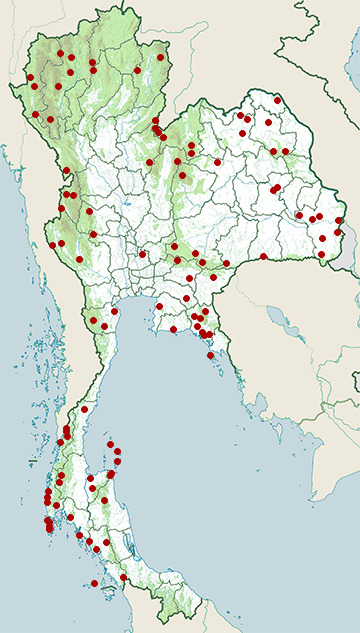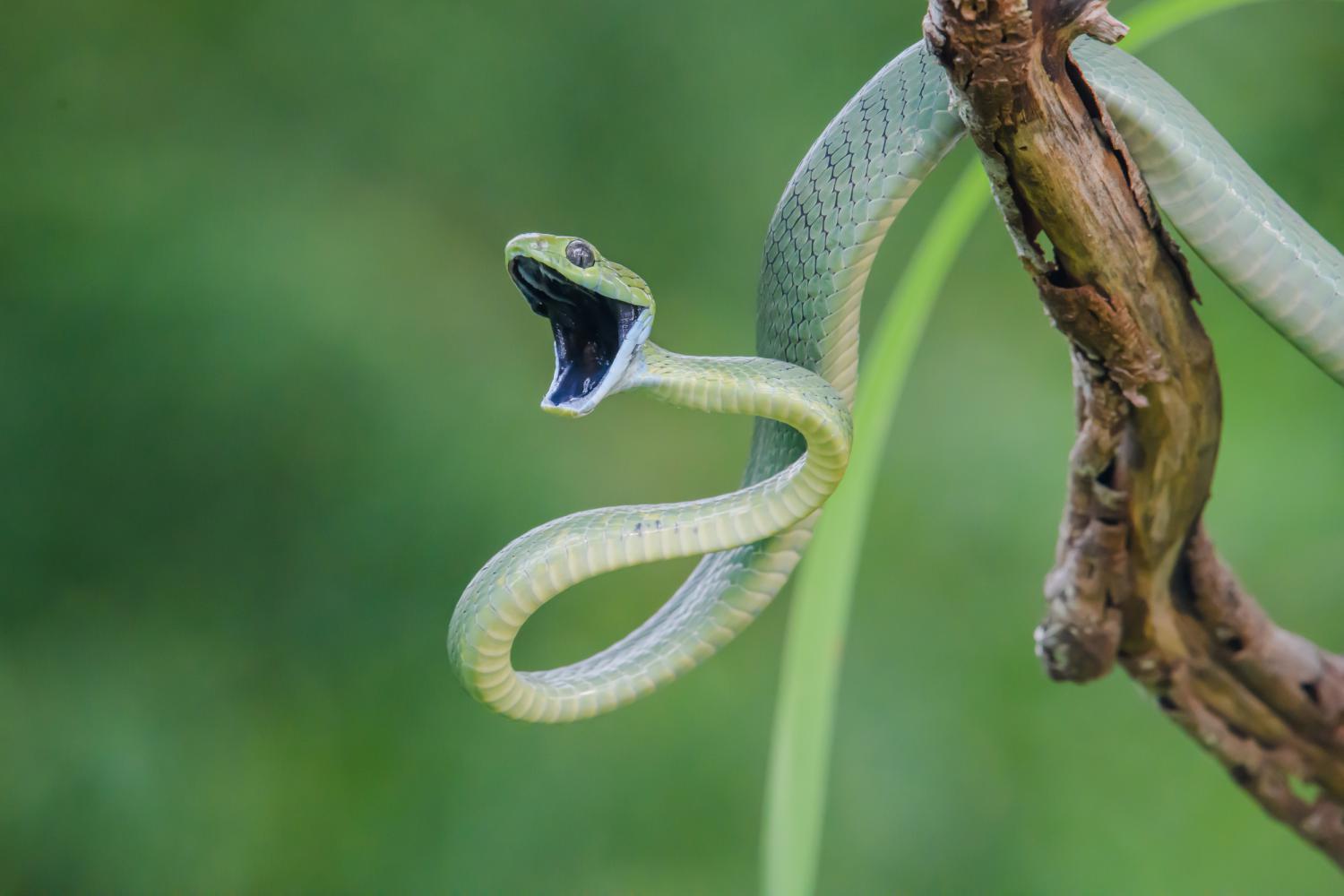Species of Thailand
Green cat snake
Boiga cyanea
(André Marie Constant Duméril, Gabriel Bibron & Auguste Duméril, 1854)
In Thai: งูเขียวบอน, ngu khiaow bon
Boiga cyanea, commonly known as the Green cat snake, is a colubrid snake species found in South Asia, China and South-east Asia.
Description
Medium to large in length, slightly compressed, medium bodied snake with a moderately long tail. Head distinct from narrow neck with a rounded snout. Eyes large in size with vertically elliptical pupils. Dorsal scales smooth with single or double apical pits. Ventrals with a feeble lateral keels. Dorsal scale count usually 21 - 21 ( 23 ) - 15. Its long prehensile tail makes it purely arboreal.
Dorsal color uniform green or green mixed with grayish or bluish. Belly color greenish or yellowish white. Top of the head usually similar to dorsal color or sometimes of brownish tint. Upper lip color yellowish; most of head scaled margined with black. Eyes golden brown. Hatchlings are reddish brown with a green head. The color of the hatchlings starts to change after 8–9 months of age.
Length: Maximum: 190 cm. Common: 115 cm. (SVL. 87 cm.)
Distribution
The green cat snake found in Bangladesh, Bhutan, Cambodia, China (Yunnan- part), India (Sikkim, Darjeeling & Jalpaiguri, West Bengal, Assam, Arunachal Pradesh, Andaman & Nicobar Islands), Laos, Malaysia (West), Myanmar, Nepal, Thailand (incl. Phuket) and Vietnam.
Ecology
Habitat: Terrestrial & arboreal; inhabits primary and secondary forests, including montane zones, and can also be found at sea level in coastal forests.
Habit: Nocturnal. Occasionally seen on the ground searching for prey. Very mild disposition, sluggish, and makes no attempt to escape when approached or when handled. Difficult to provoke into striking. By day stays coiled up amongst tree branches, but by night actively hunts for prey.
Diet: Carnivorous; feeds mainly on lizards. Also takes frogs, birds, rodents and also other snakes. This rear fanged & mildly venomous snake can paralyze small prey. If threatened, it will become hostile and posture with a wide open mouth.
Reproduction: Oviparous; Eggs are laid approximately 42–50 days after mating and lays 7-14 eggs from late Winters to late Summers; incubation period approximately 85 days.
Medical significance
Bites by this species not expected to cause medically significant effects and the only risk, probably small, local secondary infection. Patients presenting with bites by these snakes do not require medical attention, other than to check for infection and ensure tetanus immune status. Patients should be advised to return if local symptoms develop, suggesting secondary infection. Bites unlikely to cause more than mild to moderate local swelling & pain, occasionally local bruising, paresthesia/numbness, erythema or bleeding, but no necrosis and no systemic effects. While most cases will be minor, not requiring admission, some cases will be more severe, requiring admission and treatment, so assess carefully before early discharge.
This article uses material from Wikipedia released under the Creative Commons Attribution-Share-Alike Licence 3.0. Eventual photos shown in this page may or may not be from Wikipedia, please see the license details for photos in photo by-lines.
Scientific classification
- Kingdom
- Animalia
- Phylum
- Chordata
- Class
- Reptilia
- Order
- Squamata
- Suborder
- Serpentes
- Family
- Colubridae
- Genus
- Boiga
- Species
- Boiga cyanea
Common names
- German:
- Grüne Katzennatter
- Grüne Nachtbaumnatter
- English: Green cat snake
- Thai: งูเขียวบอน, ngu khiaow bon
Photos
Please help us review our species pages if wrong photos are used or any other details in the page is wrong. We can be reached via our contact us page.
Range Map

- Ban Dung District, Udon Thani
- Ban Na San District, Surat Thani
- Chae Son National Park
- Dan Sai District, Loei
- Det Udom District, Ubon Ratchathani
- Doi Inthanon National Park
- Doi Phu Kha National Park
- Doi Suthep - Pui National Park
- Don Mot Daeng District, Ubon Ratchathani
- Erawan National Park
- Hat Khanom - Mu Koh Thale Tai National Park
- Huai Kha Khaeng Wildlife Sanctuary
- Huai Nam Dang National Park
- Huai Thap Than - Had Samran Wildlife Sanctuary
- Kabin Buri District, Prachinburi
- Kaeng Hang Maeo District, Chanthaburi
- Kaeng Krachan National Park
- Kaeng Tana National Park
- Kantang District, Trang
- Kapo Waterfall Forest Park
- Khanom District, Nakhon Si Thammarat
- Khao Khiao - Khao Chomphu Wildlife Sanctuary
- Khao Khitchakut District, Chanthaburi
- Khao Lak - Lam Ru National Park
- Khao Luang National Park
- Khao Soi Dao Wildlife Sanctuary
- Khao Sok National Park
- Khao Tha Petch Wildlife Conservation and Developme
- Khao Yai Da
- Khao Yai National Park
- Khlong Bang Yai Forest Park
- Khlong Saeng Wildlife Sanctuary
- Khlung District, Chanthaburi
- Khueang Nai District, Ubon Ratchathani
- Khun Chae National Park
- Khun Yuam District, Mae Hong Son
- Ko Chang District, Trat
- Ko Lanta District, Krabi
- Ko Pha Ngan
- Ko Pha-ngan District, Surat Thani
- Ko Samui District, Surat Thani
- Kra Buri District, Ranong
- La-un District, Ranong
- Mae La Noi District, Mae Hong Son
- Mae Ngao National Park
- Mae Taeng District, Chiang Mai
- Mueang Chanthaburi District, Chanthaburi
- Mueang Krabi District, Krabi
- Mueang Phang Nga District, Phang Nga
- Mueang Phetchaburi District, Phetchaburi
- Mueang Phuket District, Phuket
- Mueang Ranong District, Ranong
- Mueang Ubon Ratchathani District, Ubon Ratchathani
- Na Haeo District, Loei
- Na Yong District, Trang
- Nakhon Luang District, Phra Nakhon Si Ayutthaya
- Nam Nao National Park
- Nam Yuen District, Ubon Ratchathani
- Namtok Pha Charoen National Park
- Namtok Phlio National Park
- Nanthaburi National Park
- Non Din Daeng District, Buriram
- Nong Han District, Udon Thani
- Nong Hin District, Loei
- Omkoi District, Chiang Mai
- Pak Chong District, Nakhon Ratchasima
- Phu Khiao Wildlife Sanctuary
- Phu Kradueng District, Loei
- Phu Phan District, Sakon Nakhon
- Phu Soi Dao National Park
- Phu Suan Sai National Park
- Phu Toei National Park
- Phu Wiang District, Khon Kaen
- Phu Wua Wildlife Sanctuary
- Phuket Province
- Sakaerat Environmental Research Station
- Sang Khom District, Udon Thani
- Selaphum District, Roi Et
- Sikao District, Trang
- Sirinat National Park
- Sirindhorn District, Ubon Ratchathani
- Takua Pa District, Phang Nga
- Tao Ngoi District, Sakon Nakhon
- Tarutao National Marine Park
- Tha Mai District, Chanthaburi
- Tha Takiap District, Chachoengsao
- Tha Yang District, Phetchaburi
- Thai Mueang District, Phang Nga
- Thalang District, Phuket
- Thale Ban National Park
- Thap Lan National Park
- Thong Pha Phum District, Kanchanaburi
- Thong Pha Phum National Park
- Thung Khao Luang District, Roi Et
- Thung Salaeng Luang National Park
- Thung Yai Naresuan Wildlife Sanctuary
- Umphang District, Tak
- Umphang Wildlife Sanctuary
- Wanon Niwat District, Sakon Nakhon
- Watthana Nakhon District, Sa Kaeo




